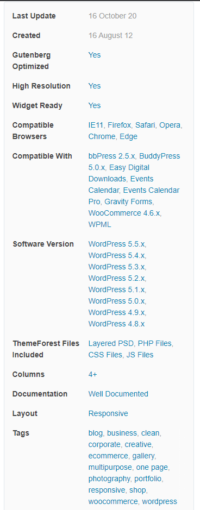How to find a WordPress theme that suits you perfectly.
Marc Wagner
October 26, 2022
Finding a WordPress theme has become a big challenge at times. The number of themes that are out there has just grown tremendously and everyone is trying to get a piece of the pie. And as it is in marketing, all theme authors lure with super great features and settings that are not so great at second glance.
So you have to pay attention not only to the fact that your theme has a great design, but also to which plugins are used and what kind of setting you are given.
Today I’ll tell you what you should look for before choosing a theme.
What is a WordPress Theme? #
Web designs that have been integrated into WordPress are called themes . Professional themes offer you settings options that allow you to change the look of your website without programming knowledge.
WordPress separates the content of your website from the design. This allows you to change your theme at any time without losing your content.
You can also customize and extend a theme if the settings options are not enough. You can either customize the stylesheet via the WordPress “Customizer” or add new functions directly via a “Child-Theme”.
Where can I find WordPress themes? #
There are both free and paid themes.
You can find free themes directly at WordPress. For security reasons, I recommend you to get free themes only from WordPress directly. The free themes are ideal for trying out and getting to know WordPress. But make sure you don’t fall for an expensive freemium model.
You can find paid themes at ThemeForest, MOJO Marketplace and TemplateMonster, among others. The advantage of premium themes is clean technical base, professional responsive design and good support. We prefer themes that are based on PageBuilders like Elementor, WPBakery or Divi .
What should your theme be able to do? #
Before you start searching through the stores, you should take a moment to think about what exactly you need.
The easiest way to make it work is to get inspiration from other sites you like. Now pick out a few websites that you particularly like. Then take a pad and pencil and write down all the points you like and why.
Define important functions
Besides the design, you should also think about the features you need for your project.
Here we divide the list into two items. On the one hand a list of functions that you absolutely need and on the other hand functions that you would only like to have, but which can also be realized for example by a plugin.
The best thing you can do is ask yourself questions like these:
- Can colors and fonts be changed?
- Can I customize the navigation?
- Will the site be multilingual?
- Do I need a page builder?
- Do I want to realize an online store?
- Do I need a blog?
- Should discussions be made possible?
- Is the theme responsive?
- Do I need a slider?
The search can begin! #
You now know what you want and can finally start looking.
It’s best to pick out several designs right away and match them with your lists. Many themes offer live demos and showcases that you can use to get a better look at the features.
Some sites, such as ThemeForest, also show you a wide range of information directly on the store page.
ThemeForest, for example, shows not only the supported WordPress version but also compatible plugins and how well the theme has been documented.
Also supported browsers and the new Gutenberg editor introduced with WordPress 5.0 are taken into account.
But not always the store page is designed so clearly, so you should always look carefully.

This is what you should look for in a WordPress theme!
In addition to your two lists, you should pay attention to the following points so that you are not disappointed afterwards.
When was the last update?
You should make sure that the theme is updated regularly. Because otherwise it can happen that with the next update your website no longer works. By updating your theme, you also ensure that discovered security vulnerabilities are closed.
Themes that have not been updated for a long time or that are not compatible with the current WordPress version should be ignored.
How do the reviews for the theme turn out?
You should get an overview of the reviews about the theme. Relevant are especially the ratings between 1 and 3 stars, because these usually indicate that something did not work with the theme. A look at the support forum is also helpful. If you find mostly open tickets there, this indicates that user feedback is rarely or not at all addressed.
Themes that have only 5 star ratings should also be examined skeptically.
Number of active installation / number of sales
For themes that you get via WordPress, you can easily see how many active installations there are. Themes that have been installed frequently are obviously more popular and of better quality.
For paid themes, instead of looking at active installs, you can look at sales.
How good is the documentation of the theme?
Good documentation of the theme shows that the developers are trying to do quality work. It also helps you find your way around faster. In most cases, the documentation also lists frequently asked questions or known problems.
Look at the documentation beforehand and check if you can cope with it, because most of the time the documentation is only available in the author’s language.
Is the theme responsive?
A responsive theme is a MUST! Make sure that the theme you choose is also optimized for tablets and smartphones. This is important not only for your visitors, but also for your SEO.
Google has already started converting its bots to mobile first. So if you want to achieve a good ranking, there is no way around a good responsive design.
How are the loading times of the theme?
In addition to the presentation, the loading time also plays an important role in the ranking of your page in search engines. You should therefore make sure that your website can be opened quickly both on the road and at home.
Ideally, you check this with the offered theme preview. Tools like GTMetrix and Google PageSpeed Insights help you find out how the theme performs.
How to install your WordPress theme #
Now that you’ve hopefully found your theme, all you have to do is install it.
You can install the free themes directly from your WordPress admin panel. To do this, go to the “Design > Themes > Add Themes” section and simply use the search to find the theme you want.
For the paid themes you will receive an archive (ZIP) which you can easily install via “Design > Themes > Add Theme > Upload Theme”.
Before you directly start adding content to your site, you should take the time to try it out. Try to find out for yourself if you like the features and the PageBuilder and if not, just change your theme.
If you’d like some help choosing your theme or have any other questions about WordPress, feel free to schedule a free consultation with us. We are happy to be there for you.
Do you have any questions about this topic? Then feel free to leave us a comment.
Artikel von:
Marc Wagner
Hi Marc here. I’m the founder of Forge12 Interactive and have been passionate about building websites, online stores, applications and SaaS solutions for businesses for over 20 years. Before founding the company, I already worked in publicly listed companies and acquired all kinds of knowledge. Now I want to pass this knowledge on to my customers.

